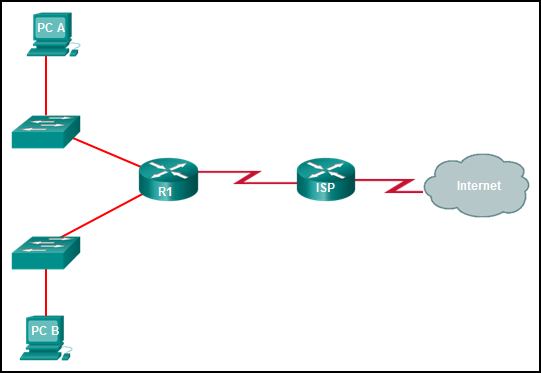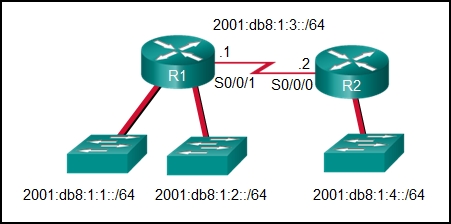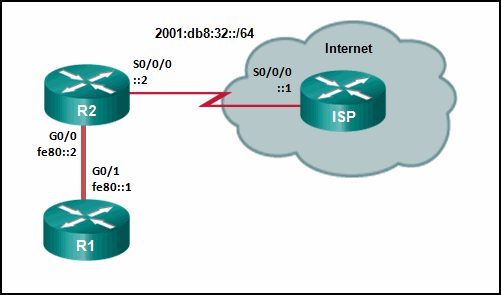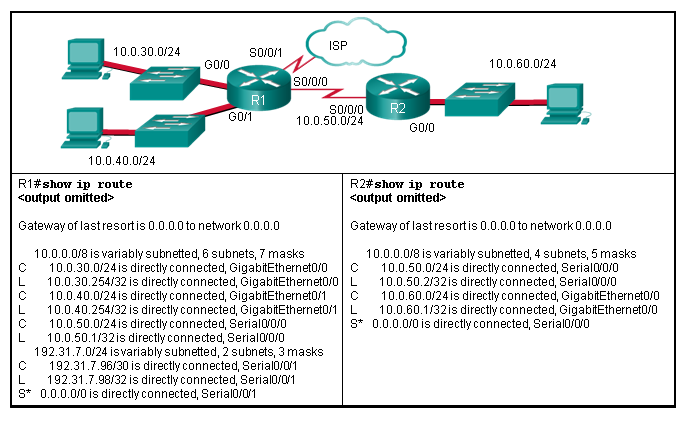Last Updated on April 3, 2018 by Admin
CCNA 2 Chapter 6
From year to year, Cisco has updated many versions with difference questions. The latest version is version 6.0 in 2018. What is your version? It depends on your instructor creating your class. We recommend you to go thought all version if you are not clear. While you take online test with netacad.com, You may get random questions from all version. Each version have 1 to 10 different questions or more. After you review all questions, You should practice with our online test system by go to "Online Test" link below.
-
What are two advantages of static routing over dynamic routing? (Choose two.)
- Static routing is more secure because it does not advertise over the network.
- Static routing scales well with expanding networks.
- Static routing requires very little knowledge of the network for correct implementation.
- Static routing uses fewer router resources than dynamic routing.
- Static routing is relatively easy to configure for large networks.
-
Refer to the exhibit. Which is the best way for PC A and PC B to successfully communicate with sites on the Internet?
- Configure a static route from R1 to ISP and a dynamic route from ISP to R1.
- Configure a default route from R1 to ISP and a static route from ISP to R1.
- Configure a dynamic route from R1 to ISP and a static route from ISP to R1.
- Configure a routing protocol between R1 and ISP and advertise all the routes.
-
What type of route allows a router to forward packets even though its routing table contains no specific route to the destination network?
- dynamic route
- default route
- destination route
- generic route
-
Why would a floating static route be configured with an administrative distance that is higher than the administrative distance of a dynamic routing protocol that is running on the same router?
- to be used as a backup route
- to load-balance the traffic
- to act as a gateway of last resort
- to be the priority route in the routing table
-
Which type of static route that is configured on a router uses only the exit interface?
- recursive static route
- directly connected static route
- fully specified static route
- default static route
-
Refer to the graphic. Which command would be used on router A to configure a static route to direct traffic from LAN A that is destined for LAN C?
- A(config)# ip route 192.168.4.0 255.255.255.0 192.168.5.2
- A(config)# ip route 192.168.4.0 255.255.255.0 192.168.3.2
- A(config)# ip route 192.168.5.0 255.255.255.0 192.168.3.2
- A(config)# ip route 192.168.3.0 255.255.255.0 192.168.3.1
- A(config)# ip route 192.168.3.2 255.255.255.0 192.168.4.0
-
The network administrator configures the router with the ip route 172.16.1.0 255.255.255.0 172.16.2.2 command. How will this route appear in the routing table?
- C 172.16.1.0 is directly connected, Serial0/0
- S 172.16.1.0 is directly connected, Serial0/0
- C 172.16.1.0 [1/0] via 172.16.2.2
- S 172.16.1.0 [1/0] via 172.16.2.2
-
Refer to the exhibit. What two commands will change the next-hop address for the 10.0.0.0/8 network from 172.16.40.2 to 192.168.1.2? (Choose two.)
- A(config)# no network 10.0.0.0 255.0.0.0 172.16.40.2
- A(config)# no ip address 10.0.0.1 255.0.0.0 172.16.40.2
- A(config)# no ip route 10.0.0.0 255.0.0.0 172.16.40.2
- A(config)# ip route 10.0.0.0 255.0.0.0 s0/0/0
- A(config)# ip route 10.0.0.0 255.0.0.0 192.168.1.2
-
Refer to the exhibit. The network administrator needs to configure a default route on the Border router. Which command would the administrator use to configure a default route that will require the least amount of router processing when forwarding packets?
- Border(config)# ip route 0.0.0.0 0.0.0.0 198.133.219.5
- Border(config)# ip route 0.0.0.0 0.0.0.0 198.133.219.6
- Border(config)# ip route 0.0.0.0 0.0.0.0 s0/0/1
- Border(config)# ip route 0.0.0.0 0.0.0.0 s0/0/0
-
Refer to the exhibit. What command would be used to configure a static route on R1 so that traffic from both LANs can reach the 2001:db8:1:4::/64 remote network?
- ipv6 route ::/0 serial0/0/0
- ipv6 route 2001:db8:1:4::/64 2001:db8:1:3::1
- ipv6 route 2001:db8:1:4::/64 2001:db8:1:3::2
- ipv6 route 2001:db8:1::/65 2001:db8:1:3::1
-
Refer to the exhibit. Which default static route command would allow R1 to potentially reach all unknown networks on the Internet?
- R1(config)# ipv6 route 2001:db8:32::/64 G0/0
- R1(config)# ipv6 route ::/0 G0/0 fe80::2
- R1(config)# ipv6 route ::/0 G0/1 fe80::2
- R1(config)# ipv6 route 2001:db8:32::/64 G0/1 fe80::2
-
Which two statements describe classful IP addresses? (Choose two.)
- It is possible to determine which class an address belongs to by reading the first bit.
- The number of bits used to identify the hosts is fixed by the class of the network.
- Only Class A addresses can be represented by high-order bits 100.
- Up to 24 bits can make up the host portion of a Class C address.
- All subnets in a network are the same size.
- Three of the five classes of addresses are reserved for multicasts and experimental use.
-
A company has several networks with the following IP address requirements:
IP phones – 50
PCs – 70
IP cameras – 10
wireless access points – 10
network printers – 10
network scanners – 2
Which block of addresses would be the minimum to accommodate all of these devices if each type of device was on its own network?
- 172.16.0.0/25
- 172.16.0.0/24
- 172.16.0.0/23
- 172.16.0.0/22
-
What does VLSM allow a network administrator to do?
- utilize one subnet mask throughout a hierarchical network
- utilize multiple routing protocols within an autonomous system
- utilize one dynamic routing protocol throughout the entire network
- utilize multiple different subnet masks in the same IP address space
- utilize one public IP address to translate multiple private addresses
-
What would be the best summary route for the following networks?
10.50.168.0/23
10.50.170.0/23
10.50.172.0/23
10.50.174.0/24
- 10.50.160.0/22
- 10.50.164.0/23
- 10.50.168.0/16
- 10.50.168.0/21
- 10.50.168.0/22
- 10.50.168.0/23
-
What is a valid summary route for IPv6 networks 2001:0DB8:ACAD:4::/64, 2001:0DB8:ACAD:5::/64, 2001:0DB8:ACAD:6::/64, and 2001:0DB8:ACAD:7::/64?
- 2001:0DB8:ACAD:0000::/63
- 2001:0DB8:ACAD:0000::/64
- 2001:0DB8:ACAD:0004::/62
- 2001:0DB8:ACAD:0004::/63
-
Refer to the exhibit. The network engineer for the company that is shown wants to use the primary ISP connection for all external connectivity. The backup ISP connection is used only if the primary ISP connection fails. Which set of commands would accomplish this goal?
- ip route 198.133.219.24 255.255.255.252
ip route 64.100.210.80 255.255.255.252 - ip route 198.133.219.24 255.255.255.252
ip route 64.100.210.80 255.255.255.252 10 - ip route 0.0.0.0 0.0.0.0 s0/0/0
ip route 0.0.0.0 0.0.0.0 s0/1/0 - ip route 0.0.0.0 0.0.0.0 s0/0/0
ip route 0.0.0.0 0.0.0.0 s0/1/0 10
- ip route 198.133.219.24 255.255.255.252
-
Which three IOS troubleshooting commands can help to isolate problems with a static route? (Choose three.)
- show version
- ping
- tracert
- show ip route
- show ip interface brief
- show arp
-
Refer to the exhibit. The small company shown uses static routing. Users on the R2 LAN have reported a problem with connectivity. What is the issue?
- R2 needs a static route to the R1 LANs.
- R1 and R2 must use a dynamic routing protocol.
- R1 needs a default route to R2.
- R1 needs a static route to the R2 LAN.
- R2 needs a static route to the Internet.
-
What happens to a static route entry in a routing table when the outgoing interface is not available?
- The route is removed from the table.
- The router polls neighbors for a replacement route.
- The route remains in the table because it was defined as static.
- The router redirects the static route to compensate for the loss of the next hop device.
-
Open the PT activity. Perform the tasks in the activity instructions and then answer the question. What is the name of the web server that is displayed in the webpage?
- Main-Webserver
- WWW-Server
- Webserver10
- MNSRV
-
Open the PT Activity. Perform the tasks in the activity instructions and then answer the question.
What IPv6 static route can be configured on router R1 to make a fully converged network?
- ipv6 route 2001:db8:10:12::/64 S0/0/1
- ipv6 route 2001:db8:10:12::/64 S0/0/0
- ipv6 route 2001:db8:10:12::/64 2001:db8:10:12::1
- ipv6 route 2001:db8:10:12::/64 2001:db8:32:77::1
From year to year, Cisco has updated many versions with difference questions. The latest version is version 6.0 in 2018. What is your version? It depends on your instructor creating your class. We recommend you to go thought all version if you are not clear. While you take online test with netacad.com, You may get random questions from all version. Each version have 1 to 10 different questions or more. After you review all questions, You should practice with our online test system by go to "Online Test" link below.





